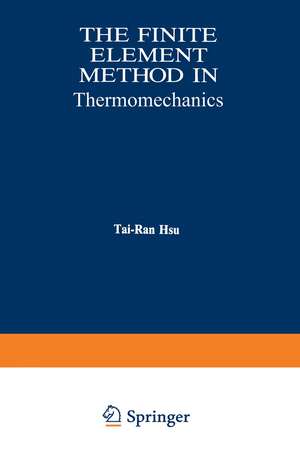The Finite Element Method in Thermomechanics
Autor Tai-Ran Hsuen Limba Engleză Paperback – 12 feb 2012
Preț: 394.87 lei
Nou
Puncte Express: 592
Preț estimativ în valută:
75.58€ • 82.13$ • 63.53£
75.58€ • 82.13$ • 63.53£
Carte tipărită la comandă
Livrare economică 21 aprilie-05 mai
Preluare comenzi: 021 569.72.76
Specificații
ISBN-13: 9789401160001
ISBN-10: 9401160007
Pagini: 412
Ilustrații: XX, 392 p.
Dimensiuni: 155 x 235 x 22 mm
Greutate: 0.58 kg
Ediția:Softcover reprint of the original 1st ed. 1986
Editura: SPRINGER NETHERLANDS
Colecția Springer
Locul publicării:Dordrecht, Netherlands
ISBN-10: 9401160007
Pagini: 412
Ilustrații: XX, 392 p.
Dimensiuni: 155 x 235 x 22 mm
Greutate: 0.58 kg
Ediția:Softcover reprint of the original 1st ed. 1986
Editura: SPRINGER NETHERLANDS
Colecția Springer
Locul publicării:Dordrecht, Netherlands
Public țintă
ResearchCuprins
1 Fundamentals of the Finite Element Method.- 1.1 Introduction.- 1.2 The concept of discretization.- 1.3 Steps in the finite element method.- References.- 2 Finite Element Analysis in Heat Conduction.- 2.1 Introduction.- 2.2 Review of basic formulations.- 2.3 Finite element formulation of transient heat conduction in solids.- 2.4 Transient heat conduction in axisymmetric solids.- 2.5 Computation of the thermal conductivity matrix.- 2.6 Computation of the heat capacitance matrix.- 2.7 Computation of thermal force matrix.- 2.8 Transient heat conduction in the time domain.- 2.9 Boundary conditions 45 2.10 Solution procedures for axisymmetric structures.- References.- 3 Thermoelastic-Plastic Stress Analysis.- 3.1 Introduction.- 3.2 Mechanical behavior of materials.- 3.3 Review of basic formulations in linear elasticity theory.- 3.4 Basic formulations in nonlinear elasticity.- 3.5 Elements of plasticity theory.- 3.6 Strain hardening.- 3.7 Plastic potential (yield) function.- 3.8 Prandtl-Reuss relation.- 3.9 Derivation of plastic stress-strain relations.- 3.10 Constitutive equations for thermoelastic-plastic stress analysis.- 3.11 Derivation of the [Cep] matrix.- 3.12 Determination of material stiffness (H’).- 3.13 Thermoelastic-plastic stress analysis with kinematic hardening rule.- 3.14 Finite element formulation of thermoelastic-plastic stress analysis.- 3.15 Finite element formulation for the base TEPSAC code.- 3.16 Solution procedure for the base TEPSA code.- References.- 4 Creep Deformation of Solids by Finite Element Analysis.- 4.1 Introduction.- 4.2 Theoretical background.- 4.3 Constitutive equations for thermoelastic-plastic creep stress analysis.- 4.4 Finite element formulation of thermoelastic-plastic creep stress analysis.- 4.5 Integration schemes.- 4.6 Solutionalgorithm.- 4.7 Code verification.- 4.8 Closing remarks.- References.- 5 Elastic-Plastic stress analysis with Fourier Series.- 5.1 Introduction.- 5.2 Element equation for elastic axisymmetric solids subject to nonaxisymmetric loadings.- 5.3 Stiffness matrix for elastic solids subject to nonaxisymmetric loadings.- 5.4 Elastic-plastic stress analysis of axisymmetric solids subject to nonaxisymmetric loadings.- 5.5 Derivation of element equation.- 5.6 Mode mixing stiffness equations.- 5.7 Circumferential integration scheme.- 5.8 Numerical example.- 5.9 Discussion of the numerical example.- 5.10 Summary.- References.- 6 Elastodynamic stress analysis with Thermal Effects.- 6.1 Introduction.- 6.2 Theoretical background.- 6.3 Hamilton’s variational principle.- 6.4 Finite element formulation.- 6.5 Direct time integration scheme.- 6.6 Solution algorithm.- 6.7 Numerical illustration.- References.- 7 Thermofracture Mechanics.- 1: Review of fracture mechanics concept.- 2: Thermoelastic-plastic fracture analysis page.- 3: Thermoelastic-plastic creep fracture analysis.- References.- 8 Thermoelastic-Plastic Stress Analysis By Finite Strain Theory.- 8.1 Introduction.- 8.2 Lagrangian and Eulerian coordinate systems.- 8.3 Green and Almansi strain tensors.- 8.4 Lagrangian and Kirchhoff stress tensors.- 8.5 Equilibrium in the large.- 8.6 Equilibrium in the small.- 8.7 The boundary conditions.- 8.8 The constitutive equation.- 8.9 Equations of equilibrium by the principle of virtual work.- 8.10 Finite element formulation.- 8.11 Stiffness matrix [K2].- 8.12 Stiffness matrix [K3].- 8.13 Constitutive equations for thermoelastic-plastic stress analysis.- 8.14 The finite element formulation.- 8.15 The computer program.- 8.16 Numerical examples.- References.- 9 Coupled Thermoelastic-PlasticStress Analysis.- 9.1 Introduction.- 9.2 The energy balance concept.- 9.3 Derivation of the coupled heat conduction equation.- 9.4 Coupled thermoelastic-plastic stress analysis.- 9.5 Finite element formulation.- 9.6 The y matrix.- 9.7 The thermal moduli matrix ?.- 9.8 The internal dissipation factor.- 9.9 Computation algorithm.- 9.10 Numerical illustration.- 9.11 Concluding remarks.- References.- 10 Application of Thermomechanical Analyses in Industry.- 10.1 Introduction.- 10.2 Thermal analysis involving phase change.- 10.3 Thermoelastic-plastic stress analysis.- 10.4 Thermoelastic-plastic stress analysis by TEPSAC code.- 10.5 Simulation of thermomechanical behavior of nuclear reactor fuel elements.- References.- Appendix 1 Area coordinate system for triangular simplex elements.- Appendix 2 Numerical illustration on the implementation of thermal boundary conditions.- Appendix 3 Integrands of the mode-mixing stiffness matrix.- Appendix 4 User’s guide for TEPSAC.- Appendix 5 Listing of TEPSAC code.- Author Index.















